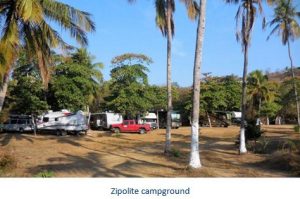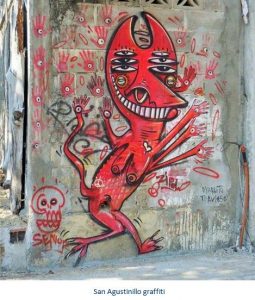By Dan and Lisa Goy from the October 2016 Edition
 On February 25, 2016 we left Puerto Arista on the coast of Chiapas and headed northwest using Hwy 200. This was Day 50 of our 90-day tour. We did hit some wind in what some might describe Wind Tunnel Alley just before you arrive at La Ventosa, and drove thru a large wind farm a few hours before our arrival in Puerto Ángel. This was a long day and we were very pleased to arrive at our destination, Fernando’s Campground, only steps away from Playa Zipolite, the only sanctioned nude beach in Mexico.
On February 25, 2016 we left Puerto Arista on the coast of Chiapas and headed northwest using Hwy 200. This was Day 50 of our 90-day tour. We did hit some wind in what some might describe Wind Tunnel Alley just before you arrive at La Ventosa, and drove thru a large wind farm a few hours before our arrival in Puerto Ángel. This was a long day and we were very pleased to arrive at our destination, Fernando’s Campground, only steps away from Playa Zipolite, the only sanctioned nude beach in Mexico.
The community known as Zipolite consists of an approximately one mile stretch of beach with a street that  parallels it. It has a central neighborhood, Colonia Roca Blanca, situated at the western end, where many of the hotels and restaurants are located. Colonia Roca Blanca is named for the island or large rock just off the shore, which is white due to bird guano.
parallels it. It has a central neighborhood, Colonia Roca Blanca, situated at the western end, where many of the hotels and restaurants are located. Colonia Roca Blanca is named for the island or large rock just off the shore, which is white due to bird guano.
Until just recently, in 2014, the main drag was the only paved street within the community. The Colonia Roca Blanca has now been completely redone, and the town now has three streets paved with yellow brick and stonework. Further behind the beach and Adoquín is a larger road that connects Zipolite with other local communities such as San Agustinillo and Puerto Ángel.
 We were keen to see just how far we ended up from the beach and were happy to find a short 3-minute walk was in our fu-ture. We celebrated our arrival with a group dinner at the Aloha Restaurant, great food, cheap cold beer, strong WiFi and a wonderful sunset on the beach. What could be better?
We were keen to see just how far we ended up from the beach and were happy to find a short 3-minute walk was in our fu-ture. We celebrated our arrival with a group dinner at the Aloha Restaurant, great food, cheap cold beer, strong WiFi and a wonderful sunset on the beach. What could be better?
Playa Zipolite is a beach community on the southern coast of Oaxaca state in Mexico between the much more popular and well known Huatulco and Puerto Escondido. As was said earlier, Zipolite is best known as being one of Mexico’s very few nude beaches and for retaining much of the hippie culture that made it notable in the 1960s and 1970s.
 The name Zipolite, sometimes spelled Sipolite or Cipolite probably comes from the Nahuatl word sipolitlan or zipotli, meaning “bumpy place” or “place of continuous bumps or hills”. Others claim the name means “beach of the dead” in either Nahuatl or Zapotec because of dangerous underwater currents just offshore.
The name Zipolite, sometimes spelled Sipolite or Cipolite probably comes from the Nahuatl word sipolitlan or zipotli, meaning “bumpy place” or “place of continuous bumps or hills”. Others claim the name means “beach of the dead” in either Nahuatl or Zapotec because of dangerous underwater currents just offshore.
We found the beach was very popular with gay men, Europe-ans and the younger set, especially backpackers, who stay in one of the many rustic cabins or camping spaces that line the beach.
This was our last serious beach time before heading inland for 3 weeks so we made the most of it. Lots of time in the water, on the beach and strolling thru town and the nearby community of San Agustinillo. Collectively we visited many different restaurants over our 4 night stay, where it was hot and humid for sure, as was the ocean. We did have electricity, unfortunately not enough to run the AC, almost enough to run the fans.
Interesting that in the 1960s and 1970s, counterculture hippies began to congregate here in part due to the  beach’s isolated nature. At the time, there was little law enforcement, and drug use became common. In the 1970s and 1980s the beach gained a reputation in Mexico and among foreign travelers as a free-love paradise. In the 1990s and early 2000s, Zipolite was hard hit by two hurricanes and a fire.
beach’s isolated nature. At the time, there was little law enforcement, and drug use became common. In the 1970s and 1980s the beach gained a reputation in Mexico and among foreign travelers as a free-love paradise. In the 1990s and early 2000s, Zipolite was hard hit by two hurricanes and a fire.
The first hurricane was Hurricane Pauline on 7 October 1997, a category four storm which destroyed nearly everything in town with strong flooding, leaving it -along with Mazunte and Puerto Ángel cut off from the mainland, but there were no deaths.
Next was Hurricane Rick on 9 November 1997. While not as strong as Pauline, the storm damaged roads and other infra-structure that was only partially rebuilt after Pauline. The last disaster to cause major damage  was a fire that broke out on 21 February 2001, burning many of the wood and palm-thatched structures that were on the beach. You could see that the campground owner’s house had been badly damaged by previous hurricanes as only the concrete bearing walls and roofline remained on the 2nd floor.
was a fire that broke out on 21 February 2001, burning many of the wood and palm-thatched structures that were on the beach. You could see that the campground owner’s house had been badly damaged by previous hurricanes as only the concrete bearing walls and roofline remained on the 2nd floor.
It is obvious that there are no building codes enforced here, so constructions vary as to materials and quality. There are no banking services here either although an automated teller ma-chine (ATM) has been recently installed in the Roca Blanca.
There is also an ATM and a branch of Banco Azteca in Puerto Ángel. There is no currency exchange either, but many places take US dollars and a few places even accept credit cards.
Almost all the establishments that face the beach have palapa sheltered restaurants and bars in front and lodging in the back.
These lodgings can vary from wood huts, to simple concrete structures and often include hammocks and places to pitch tents. Another highlight for Zipolite is the variety of restaurants from the standard Mexican to international cuisine and vegetarian choices.
Many of the local restaurants are owned by expatriate Italians and serve pasta dishes as well as pizza.  Another restaurant serves crepes because of its French expatriate owner. Nightlife in Zipolite is subdued, however, in the high season (November through May), some surprisingly good musicians pass through town. Some of our gang stayed out late enough to enjoy some of the entertainment. The local band, the Zipolite Beach Billies, hosts a weekly open mic that is very popular among tourists and locals alike. Many of the beachfront hotels have their own small bars and there are a number of small nightclubs such as Libelula Bar, Zipolipas and La Puesta. Posada Mexico also frequently hosts live music. There is a large yoga community in Zipolite with classes being offered at the Alquimista and Loma Linda. Our stop here was well worth it, lots of fun and great memories. Enjoy our photo tour!
Another restaurant serves crepes because of its French expatriate owner. Nightlife in Zipolite is subdued, however, in the high season (November through May), some surprisingly good musicians pass through town. Some of our gang stayed out late enough to enjoy some of the entertainment. The local band, the Zipolite Beach Billies, hosts a weekly open mic that is very popular among tourists and locals alike. Many of the beachfront hotels have their own small bars and there are a number of small nightclubs such as Libelula Bar, Zipolipas and La Puesta. Posada Mexico also frequently hosts live music. There is a large yoga community in Zipolite with classes being offered at the Alquimista and Loma Linda. Our stop here was well worth it, lots of fun and great memories. Enjoy our photo tour!
Download the full edition or view it online
Dan and Lisa Goy, owners of Baja Amigos RV Caravan Tours, have been making Mexico their second home for more than 30 years and love to introduce Mexico to newcomers.










